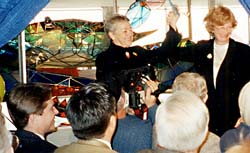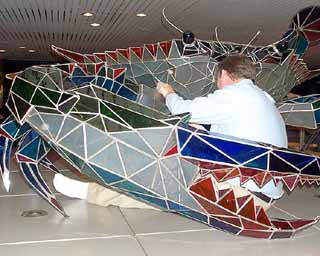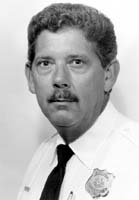| At BWI, No Crab Shortage
by M.L. Faunce
Artist Jackie Leatherbury Douglass and County Executive Janet Owens introduce the restored glass crab at BWI.
A rare species of crab has returned to Chesapeake Country. Calinectes douglassi is once again making its home at BWI airport. Maryland's international airport may not be the ordinary environment for a crustacean, but this is no ordinary crab.
At 51/2 feet tall, 10 feet long and seven feet wide, this crab sparkles with every color of glass imaginable. It is completely self-supporting, a remarkable feat for a 400-pound crustacean of 5,000 hand-crafted stained-glass pieces held together by welded steel. Making the crab took artists Jackie Leatherbury Douglass, the designer, and her husband John 5,500 hours over 14 months.
That was in the mid-1980s, when the Shady Side artists undertook the Anne Arundel County Economic Development Corp. commission to make a one-of-a-kind blue crab to illuminate the county's promise. Their mega-crab settled in BWI's main concourse, but it has been banished for nearly a decade after damaged sustained during an earlier move.
9pm December 14–This December night, Calinectes douglassi has come home. Transported from the county warehouse in Millersville, the gigantic Chesapeake Bay blue crab arrived at 8pm to be assembled in the lounge between Concourses C and D, where crates, cameras, engineers and spectators surround it.
Armed with a bottle of spray cleaner, Anne Arundel County facilities administrator David Wines busily polishes the rainbow glass. He's been keeper of the crab for over two years, while the complicated business of its repair was negotiated. "I can't say it's been a labor of love," says Wines. "It's been exciting but stressful."
by Sharon Brewer
His stress is almost over, for the crab has reached its new home, where each of its 11 pieces emerged unbroken from its wooden crate. Next, like a breakable, three-dimensional puzzle, it's reassembled which, Wines says, is always the hard part.
But by 9pm it's poised intact on glass claws on its platform, and the lights come on, bringing the crab to life. Rainbow colors reflect in all directions.
Work continues through the night as designer Peter Tasi of Maritime Plastics of Eastport hovers over the crab like an expectant mother, fretting quietly about the "tight fit" of the octagonal acrylic case he's designed to protect Calinectes douglassi. The night passes with satisfaction as well as stress and distress. An airport worker who hasn't seen the crab since it was put in storage throws open his arms in welcome.
10am December 15–Ohs, ahs and accolades surround Calinectes douglassi from the adoring crowd gathered to welcome its - in fact, her - return. Her huge, bulbous blue eyes look skyward with promise. With antennae alert, six delicate legs danced on their red tips, revealing her cool aqua underbelly and apron. A cerulean blue open claw seems not so menacing as purposeful.
It's a triumph for the Douglasses, who've been riled over their crab's exile. It's a success for Anne Arundel County Executive Janet Owens, who's keeping a campaign promise in returning the crab to BWI. It's a spectacle for all who come from near and far. It's a symbol of the resources Maryland has to offer. Calinectes douglassi is home.
-Sharon Brewer and M.L. Faunce
Appreciation:
William Allen ‘Al’ Staley Sr.
 October 12, 1944 – December 6, 2000 October 12, 1944 – December 6, 2000
by Bobby Sturgell
On December 6, 2000, Anne Arundel County lost a good man, who also happened to be my brother-in-law. A 1963 graduate of Severna Park High School, Al Staley was a retired Anne Arundel County policeman who lived in Friendship and spent his later years hanging out with the boys at the Happy Harbor in Deale.
Al served 24 years on the force, the majority of that time in South County. In 1992, he received the Police Officer’s Silver Star Award for “talking down” a man attempting suicide. The man had saturated his car and himself with gasoline and was sitting in the car with a lighter in hand, ready to begin the fireworks. Al responded to the call and slowly made his way next to the vehicle, eventually convincing the man to hand over the lighter and surrender.
Al’s memorial service was a who’s who of county’s law enforcement. Remembering their friend were not only today’s officers — including Sheriff George Johnson, Captain Thomas Suit, Mike Kennedy and Tom Lawler — but also yesterday’s legends: Captain Don Ward, Jack Paine, Warren Paddy and the man who kept us walking the straight line in Deale, Officer Doug Juckett.
Al was remembered for humor as well as for heroism. Last week, one of his best friends told me a story about his wife’s first introduction to Al. Al made one of the typical dry, sarcastic remarks that only he could make. The remark so upset the wife that she left the room. “I guess she doesn’t know me too well,” Al said to his pal. Last month, the couple came to see Al at my sister’s house. By that time, he was very ill and had just been diagnosed with several new tumors. Before they left, the wife leaned over and whispered into Al’s ear, “You know, Al, I never told you but, you grew on me.”
I think that best describes Al. He kind of grew on you. I can tell you honestly that there was no love loss between Al and I when we first met. I was a protective brother, my sister had just returned home to live and the next thing I knew, there was this pencil-thin mustachioed police officer hanging around Happy Harbor three meals a day. But you know, he kind of grew on me. More important, he brought joy to my sister and I thank him for the eight years they had together.
Along with Sharon and the rest of our family, I want to thank the members of the Fraternal Order of Police for their support, presence and service to our community. Our doors will always be open to you. Thanks to Earl Hargrove, who dedicated his lane of lights to Al this year. And a special thanks to friends who helped us — not just during the past year or last few months of Al’s sickness, but over the entire 40-plus years we have lived in South County.
Missing Mistletoe in Maryland? Try Oklahoma
The key to the door of Christmas kisses will be hard to find this year. Customarily plucked from the depths of Santa's satchel and dangled from the doorway with the most foot traffic, mistletoe won't be easy to come by this year. Santa's making an extra trip to continue the American tradition of holiday kisses.
The parasite of Christmas lurks on tree branches all over the world, except in Maryland, where mistletoe - rumored to have been plentiful - is now so scarce that when it's found, it's likely to be kept secret.
Except for the bunch said to grow in the yard of one of our writer's mom's friends from church, who lives in Calvert County, there's hardly any left in Chesapeake Country. Santa will have to make friends with Bay Weekly's source or head to Oklahoma, where mistletoe reigns as the state flower.
Listed as an endangered species in Maryland, dwarf mistletoe, or Arceuthobium pusillum, grows on trunks and branches of trees, most often pine trees in the Eastern United States. Lacking roots, the mystical parasite bores through bark and gently siphons off its host's water supply. Leathery, oblong leaves complemented by tiny yellow flowers that bloom in February and March are accompanied by white, shiny berries.
An odd and unnoticed plant most of the year, mistletoe is in high demand this time of the year.
Americans are satisfied with a smooch beneath the mistletoe, but the plant could, it's said, offer more. Its powers supposedly rival Viagra, for it's legendary as an aphrodisiac and the source of a fertility potion.
In earlier centuries, mistletoe was hoarded to fend off witches and treat sick cattle and sheep. Germans believed it cured epilepsy and measles, and the Swedes thought it would protect them from trolls and fairies. Austrians thought to place a sprig under their pillow to prevent nightmares, and pregnant Italian women carried mistletoe in their pockets to ensure a safe birth.
When most plants have perished from winter's chill, the magic weed keeps its rich green color throughout the year. So it's a symbol of the new life promised by the Christmas season. It's ability to live halfway between heaven and earth secured its religious significance. But if you find some, we assume you'll use it for kissing.
Pundits, Presidents and Pat Piper
At Washington's swell St. Regis Hotel mid-month, city and country cousins basked together in the warm outer circles of celebrity. In the limelight were a pair of the same sort of cousins: the ultimate insider, Larry King, and the got-away-from-it-all Baysider Pat Piper, of Rose Haven. The reason for all the canapes and closeness was their new book, Anything Goes!
"It's Larry's book, but I wrote it," says Piper of the third collaboration of the famous easy talker and the deceptively simple writer.
"I've worked with Larry since 1984 and I know how he talks," Piper explains. "I put it into the words and it seems to work pretty well. The problem is sometimes I start talking like him."
What I've Learned from Pundits, Politicians and Presidents, as the 300-page Warner Book is subtitled, couldn't have come out at a better time. For its subject is the free-for-all of American politics.
"After the events of the past five weeks, it's a great time to have a book out with the title Anything Goes," Piper told Bay Weekly, to which he contributes the occasional wry reflection. "Because, let me tell you, it does just that. You couldn't have written this story the way it has gone. And if you did, nobody would believe it."
The partners' timing was so good that their party nearly didn't happen . With the United States Supreme Court scratching their periwigged heads over who'd be our next president, host Wolf Blitzer, the CNN newsman, was being a working journalist rather than a genial one. Reporters, including an assortment of CNN talking heads, stole an hour off the job but worried how long their night would be. Others didn't have to worry. Among that sort: Ben Bradlee and Sally Quinn and The Washington Post's Bob Woodward. . With the United States Supreme Court scratching their periwigged heads over who'd be our next president, host Wolf Blitzer, the CNN newsman, was being a working journalist rather than a genial one. Reporters, including an assortment of CNN talking heads, stole an hour off the job but worried how long their night would be. Others didn't have to worry. Among that sort: Ben Bradlee and Sally Quinn and The Washington Post's Bob Woodward.
The Court hadn't yet made its call, but Secretary of Health and Welfare Donna Shalala. who'd stopped by to schmooze, said she was packing up her office.
All of which underscored King's point: "What once was the norm is no more."
King reached that conclusion back in 1993. In four and a half years, he'd seen Bill Clinton rise from the infamy of giving the 1988's Democratic Convention's longest and dullest speech shed the mud of the Gennifer Flowers scandal beat out a half dozen able fellow Democrats and pull out the chair from under a sitting president.
1992, King says, "Had been an incredible year and we'll probably never go through another one like it and Bill Clinton must be glad, as am I, that things will finally slow down.
"I guess you could call that the Understatement of the Millennium."
From 1992 through 2000, events make King's point in clubs, diamonds and spades.
"We began this book knowing these were extraordinary times and we had an extraordinary politician who was president," says Piper. "The intersection of technology, giving us more outlets and faster turnaround of events and the remarkable events: sex with an intern wars watched live at home OJ in the Bronco on live TV the Clinton haters and the fact everytime you thought Clinton wasn't going to survive, his enemies self-destructed.
"We built on the idea we will never see times like this again, and we will be talking about this for the rest of our lives."
It's sure not over yet.
"We are writing a final chapter for the paperback edition," says Piper, "since it took 36 days to figure out who won on November 7."
Way Downstream ...
In Virginia, emotions are fraying in the town of Chesapeake now that 10,000 people have signed a petition to prevent construction of a predominately black church. Elders of the Holy Temple Ministry say the action is racially motivated, but organizers of the campaign insist that it's about zoning and land use, not race ...
In Alaska, city living is getting to moose. Graduate students at Alaska Pacific University found that moose living in Anchorage's Kincaid Park had twice the levels of a stress hormone in their droppings than moose in the wild ...
In New York, the story of toxics contamination is especially grim if you like to eat fish. People along the Upper Hudson River won't be able to eat fish for at least 20 years because of massive levels of PCBs, and then just once or twice a month. Even so, the EPA has begun a $460 million dredging project to get rid of the hazardous sediment ...
In New Jersey, Army Corps of Engineers will have the last say on whether to allow construction of a $1 billion shopping complex on the Hackensack Meadowlands, 204 acres of wetlands that have only recently recovered from severe pollution. Not surprisingly, The New York Times reported this week, the Corps initially found little environmental harm in the project, which is opposed by the EPA and the U.S. Fish and Wildlife Service
Our Creature Feature comes from Florida, where the presidential vote recount was not the only hot contest. At the Broward County Fair, a pig race included Al Boar and George W. Bush Hog. Just like in the vote-counting, Al Boar didn't fare too well. And the reason might have been the same in the pig race as it was in his presidential campaign. A photo finish at the fair showed a tie between Bush Hog and Monica Squealinsky.
Copyright 2000
Bay Weekly
|